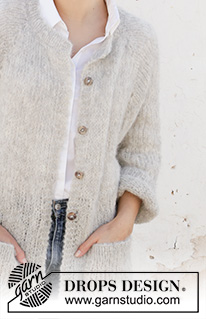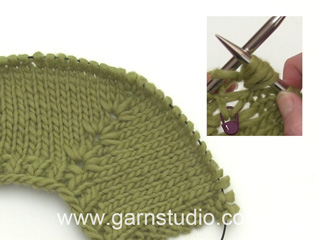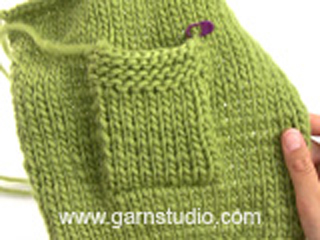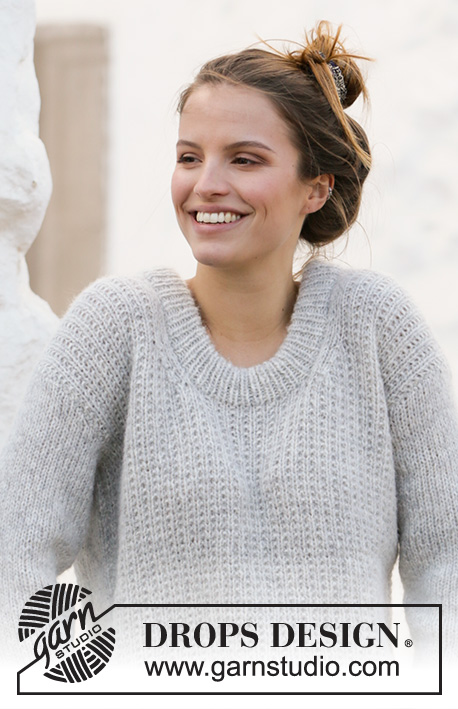Classic comfort |
|
 |
 |
Knitted jacket in DROPS Melody. Piece is knitted top down with raglan, pockets and vents in the sides. Size XS–XXL.
DROPS 210-3 |
|
|
---------------------------------------------------------- EXPLANATION FOR THE PATTERN: ---------------------------------------------------------- GARTER STITCH (back and forth): Knit all rows. 1 ridge vertically = knit 2 rows. DECREASE/INCREASE TIP (evenly): To calculate how to decrease/increase evenly, use the total number of stitches on row (e.g. 95 stitches) minus bands (e.g. 8 stitches) , and divide the remaining 87 stitches by number of decrease/increases to be done (e.g. 25) = 3.5. In this example decrease by knitting alternately approx. every 2nd and 3rd stitch and every 3rd and 4th stitch together, and do not decrease over bands. If increasing make in this example 1 yarn over after alternately approx. every 3rd and 4th stitch, and do not increase over band . On next row work yarn overs twisted to avoid holes. RAGLAN: Increase for raglan in every transition between front/back piece and sleeves as explained below. All increases are done from right side and increase every 4th row (i.e. on every other row from right side) as explained in pattern. INCREASE 4 STITCHES AS FOLLOWS: Knit 1 in stitch below stitch with marker (raglan stitch), do not slip stitches off the needle, make 1 yarn over on right needle, knit 1 in same stitch, but wait to slip off the needle, make 1 yarn over on right needle and knit 1 in same stitch, then slip the stitch off the left needle (= 4 stitches increased). Insert 1 marker in the middle of these 5 stitches (for next increase). INCREASE 2 STITCHES AS FOLLOWS: Knit 1 in stitch below stitch with marker (raglan stitch), do not slip stitches off the needle, make 1 yarn over on right needle, knit 1 in same stitch, then slip the stitch off the left needle (= 2 stitches increased). Insert 1 marker in the middle of these 3 stitches (for next increase - only applies to size L). DECREASE TIP (applies to mid under sleeves): Decrease 1 stitch on each side of marker thread as follows: Work until 3 stitches remain before marker thread, knit 2 together, knit 2 (marker thread is between these 2 stitches), slip 1 stitch knitwise, knit 1, pass slipped stitch over stitch worked (= 2 stitches decreased by marker). BUTTONHOLES: Decrease for buttonholes on right band (when garment is worn). Decrease from right side when 3 stitches remain on row as follows: Make 1 yarn over, knit the next 2 stitches together, finish with 1 stitch in garter stitch. On next row (wrong side) knit the yarn over to make a hole. Decrease first buttonhole when neck edge measures approx. 2 cm = ¾". Then decrease the next 4-4-5-5-6-6 buttonholes, approx. 9-9½-8-8½-8-8½ cm = 3½"-3¾"-3⅛"-3¼"-3⅛"-3¼" apart. BIND-OFF TIP: To avoid a tight bind-off edge you may use a larger needle size. ---------------------------------------------------------- START THE PIECE HERE: ---------------------------------------------------------- JACKET - SHORT OVERVIEW OF THE PIECE: Work neck edge and yoke back and forth on circular needle from mid front, top down. Now divide yoke for front pieces, back piece and sleeves. Work front pieces and back piece back and forth on circular needle separately, top down. Work sleeves in the round on double pointed needles/short circular needle, top down. Then work pocket to sew on. NECK EDGE: Cast on 95-99-103-105-109-111 stitches (including 4 band stitches in each side towards mid front) on circular needle size 4.5 mm = US 7 with Melody. Purl 1 row (= wrong side). Work next row as follows from right side: Work 4 band stitches in GARTER STITCH - read explanation above, * knit 1, purl 1 *, work from *-* until 5 stitches remain on row, knit 1 and finish with 4 band stitches in garter stitch. Continue rib like this for 4 cm = 1½". When rib is done, knit 1 row from right side while at the same time decreasing 25-25-25-27-27-29 stitches evenly - read DECREASE/INCREASE TIP = 70-74-78-78-82-82 stitches. Insert 1 marker after band, at the beginning of row mid front. Measure yoke from this marker! Switch to circular needle size 8 mm = US 11 and purl 1 row from wrong side with 4 band stitches in garter stitch in each side. Then work yoke as explained below. YOKE: Insert 4 markers in the piece as explained below. Use markers when increasing for raglan. Count 14-15-16-16-17-17 stitches (= front piece), insert 1 marker in next stitch, count 10 stitches (= sleeve), insert 1 marker in next stitch, count 18-20-22-22-24-24 stitches (= back piece), insert 1 marker in next stitch, count 10 stitches (= sleeve), insert 1 marker in next stitch. There are 14-15-16-16-17-17 stitches after last marker on front piece. Now work and increase for raglan as explained below: Begin from right side and work in stockinette stitch back and forth with 4 band stitches in garter stitch in each side as before. REMEMBER THE KNITTING GAUGE! AT THE SAME TIME on first row from right side increase for RAGLAN – read explanation above. I.e. increase first 4 stitches in every stitch with marker (= 16 stitches in total increased on stitches). Continue like this and increase for raglan on every 4th row (i.e. every other row from right side) 5-6-7-7-9-9 times in total vertically = 150-170-190-190-226-226 stitches. Continue with increase every 4th row, but now increase only 2 stitches in every stitch with marker, as explained above (= 8 stitches in total increased on needle). Increase 2 stitches at every marker 1-1-1-2-0-1 times in total vertically. After last increase there are 158-178-198-206-226-234 stitches on needle. Work stockinette stitch with 4 band stitches in garter stitch in each side as before, until piece measures 19-21-23-25-27-29 cm = 7½"-8¼"-9"-9¾"-10⅝"-11⅜" from marker by the neck. Now divide yoke for body and sleeves. I.e. work next row as follows: Work 27-30-32-34-38-40 stitches as before (= front piece), slip the next 30-34-40-40-42-42 stitches on 1 stitch holder for sleeve, cast on 8-8-8-10-10-12 new stitches on row (= in the side under sleeve), work 44-50-54-58-66-70 stitches as before (= back piece), slip the next 30-34-40-40-42-42 stitches on 1 stitch holder for sleeve, cast on 8-8-8-10-10-12 new stitches on needle (= in the side under sleeve), work 27-30-32-34-38-40 stitches as before (= front piece). Finish body and sleeves separately as explained below. NOW MEASURE PIECE FROM HERE! BODY: = 114-126-134-146-162-174 stitches. Insert 1 marker after 31-34-36-39-43-46 stitches in from each side (= in the side of body). There are 52-58-62-68-76-82 stitches between markers on back piece. Now divide body at the markers to work back piece separately and front pieces separately. BACK PIECE: = 52-58-62-68-76-82 stitches. Work in stockinette stitch back and forth with 2 edge stitches in garter stitch in each side until piece measures 42-43-44-45-46-47 cm = 16½"-17"-17¼"-17¾"-18"-18½" from division (approx. 5 cm = 2" remain until finished measurements, try the jacket on and work to desired length). Switch to circular needle size 4.5 mm = US 7. Knit 1 row from right side while increasing 27-29-31-35-39-41 stitches evenly - remember INCREASE/DECREASE TIP = 79-87-93-103-115-123 stitches. Work next row as follows from wrong side: 2 edge stitches in garter stitch, * purl 1, knit 1 *, repeat from *-* until 3 stitches remain on needle, purl 1, and finish with 2 edge stitches in garter stitch. Continue rib like this for 5 cm = 2". Bind off stitches with knit over knit and purl over purl - read BIND OFF TIP! Jacket measures approx. 70-73-76-79-82-85 cm = 27½"-28¾"-30"-31"-32¼"-33½" from shoulder and down. RIGHT FRONT PIECE (when garment is worn): = 31-34-36-39-43-46 stitches. Work in stockinette stitch back and forth with 2 edge stitches in garter stitch towards the side and 4 band stitches in garter stitch towards mid front until front piece measures 42-43-44-45-46-47 cm = 16½"-17"-17¼"-17¾"-18"-18½" from division (adjust according to back piece). Switch to circular needle size 4.5 mm = US 7. Knit 1 row from right side while increasing 16-17-19-20-22-23 stitches evenly = 47-51-55-59-65-69 stitches. Work next row as follows from wrong side: 4 band stitches in garter stitch, * purl 1, knit 1 *, repeat from *-* until 3 stitches remain on needle, purl 1, and finish with 2 edge stitches in garter stitch. Continue rib like this for 5 cm = 2". Bind off stitches with knit over knit and purl over purl. LEFT FRONT PIECE (when garment is worn): = 31-34-36-39-43-46 stitches. Work in stockinette stitch back and forth with 4 band stitches in garter stitch towards mid front and 2 edge stitches in garter stitch towards the side until front piece measures 42-43-44-45-46-47 cm = 16½"-17"-17¼"-17¾"-18"-18½" from division (adjust according right front piece). Switch to circular needle size 4.5 mm = US 7. Knit 1 row from right side while increasing 16-17-19-20-22-23 stitches evenly = 47-51-55-59-65-69 stitches. Work next row as follows from wrong side: 2 edge stitches in garter stitch, * purl 1, knit 1 *, repeat from *-* until 5 stitches remain on needle, purl 1, and finish with 4 band stitches in garter stitch towards mid front. Continue rib like this for 5 cm = 2". Bind off stitches with knit over knit and purl over purl. SLEEVES: Slip the 30-34-40-40-42-42 stitches from stitch holder in one side of piece on double pointed needles or short circular needle size 8 mm = US 11, and pick in addition up 1 stitch in each of the 8-8-8-10-10-12 stitches under sleeve = 38-42-48-50-52-54 stitches. Insert 1 marker thread in the middle of the 8-8-8-10-10-12 stitches under sleeve and move the marker thread upwards when working. Use marker later when decreasing mid under sleeve. Begin round at the marker thread and work stockinette stitch in the round. When sleeve measures 3 cm = 1⅛" from division in all sizes, decrease 2 stitches mid under sleeve - read DECREASE TIP. Decrease like this every 12-6-4-3-3-3 cm = 4¾"-2⅜"-1½"-1⅛"-1⅛"-1⅛" 3-5-7-8-8-8 times in total = 32-32-34-34-36-38 stitches. Work until sleeve measures 37-35-34-32-31-29 cm = 14½"-13¾"-13⅜"-12½"-12¼"-11⅜" from division (approx. 5 cm = 2" remain until finished measurements, try the jacket on and work to desired length). Knit 1 round while increasing 16-16-16-18-18-18 stitches evenly = 48-48-50-52-54-56 stitches. Switch to double pointed needles size 4.5 mm = US 7. Work rib in the round = knit 1/purl 1 for 5 cm = 2". Bind off with knit over knit and purl over purl - remember BIND-OFF TIP. Sleeve measures approx. 42-40-39-37-36-34 cm = 16½"-15¾"-15¼"-14½"-14¼"-13⅜" from division. Work the other sleeve the same way. POCKET: Cast on 22-22-24-24-26-26 stitches on circular needle size 8 mm = US 11 with Melody. Work in stockinette stitch back and forth with 2 edge stitches in garter stitch in each side. When pocket measures 13-13-14-14-15-15 cm = 5⅛"-5⅛"-5½"-5½"-6"-6", switch to circular needle size 4.5 mm = US 7. Knit 1 row from right side while increasing 11-11-13-13-13-13 stitches evenly = 33-33-37-37-39-39 stitches. Continue in rib, i.e. work first row as follows from wrong side: 2 edge stitches in garter stitch, * purl 1, knit 1 *, repeat from *-* until 3 stitches remain on needle, purl 1, and finish with 2 edge stitches in garter stitch. Continue rib like this for 4 cm = 1½". Bind off stitches with knit over knit and purl over purl. Pocket measures approx. 18-18-20-20-22-22 cm = 7"-7"-8"-8"-8¾"-8¾" in width and 17-17-18-18-19-19 cm = 6¾"-6¾"-7"-7"-7½"-7½" vertically. Work the other pocket the same way. Sew one pocket on to each front piece, directly above rib in bottom edge and approx. 5-5-6-7-7-8 cm = 2"-2"-2⅜"-2¾"-2¾"-3⅛" in from mid front (try the jacket on and adjust placement of pockets). ASSEMBLY: Sew side seams on jacket – begin at the top under sleeve and sew edge to edge in outer loops of edge stitches to get a flat seam but stop seam when approx. 12 cm = 4¾" remain at the bottom in each side (= vent). Sew the buttons on to the left band. |
|

|
|
|
Have you made this or any other of our designs? Tag your pictures in social media with #dropsdesign so we can see them! Do you need help with this pattern?You'll find tutorial videos, a Comments/Questions area and more by visiting the pattern on garnstudio.com. © 1982-2024 DROPS Design A/S. We reserve all rights. This document, including all its sub-sections, has copyrights. Read more about what you can do with our patterns at the bottom of each pattern on our site. |
|




























































Comments / Questions (41)
Størrelserne S - xxxl hvad svare det til : f.eks. xl
29.03.2020 - 16:23DROPS Design answered:
Hej Bodil, du finder målene på jakken i de forskellige størrelser i måleskitsen nederst i opskriften. God fornøjelse!
01.04.2020 - 15:50Ik brei dit patroon in de kleinste maat. De pas begint met 70 steken. Dan ga ik verdelen 14-10-18-10-14. Ik houd nu steken over. Als ik de verdeling van 1 maat groter aanhoudt 15-10-20-10-15 klopt het wel. Of moet ik 4 steken meer minderen?
16.02.2020 - 16:07DROPS Design answered:
Dag Jacky,
De steek waar je de markeerdraad in plaatst is ook 4x1 steek die meetelt in het totaal. Op die manier kom je wel op 70 steken.
23.02.2020 - 19:29Je ne trouve pas l'endroit où il faut pour changer la taille des aiguilles ainsi que l'utilisation des aiguilles doubles pointes .Trop imprécis de dire "pour le raglan" ou"pour le jersey" Pouvez vous préciser s'il vous plaît ?
06.02.2020 - 16:24DROPS Design answered:
Bonjour Chantal, les changements d'aiguilles sont indiqués dans les explications : on commence avec la petite aiguille circulaire 4,5 pour le col puis on continue avec l'aiguille circulaire 8, on ne reprendra l'aiguille 4,5 que pour la bordure du bas du dos et des devants. Les manches sont tricotées avec la petite aiguille circulaire ou les aiguilles doubles pointes 8 et la bordure du bas des manches avec les aiguilles doubles pointes 4,5. Bon tricot!
07.02.2020 - 07:40Kan dit model ook gebreid worden in één stuk, maw zonder zijnaden ??
21.01.2020 - 14:24DROPS Design answered:
Dag Kristien,
Ja, dat kan wel bij dit model. Je zet dan alle steken voor de voorpanden en het achterpand op de naald, maar zonder de kantsteken. Op de plaats waar de zijnaden komen, plaats je markeerdraden, zodat je weet waar je af moet kanten voor de armsgaten.
26.01.2020 - 14:35Gilet décontracté comme je les aime
11.01.2020 - 18:04En kofta jag absolut kommer att sticka så fort mönstret kommer och är säkert skön att ha på sig en sommarkväll vid grillen
02.01.2020 - 18:24Comfort cardi with a pretty colour
24.12.2019 - 11:19Gilet super confo!!
23.12.2019 - 02:09Schöner klassischer Begleiter
13.12.2019 - 17:05Simple mais efficace ! Trop beau
11.12.2019 - 01:35